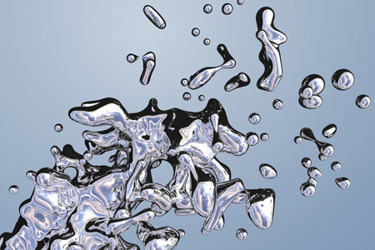Chromium In Drinking Water: New Regulations In California And Engineering Challenges
By Paniteja Madala

Among other contaminant concerns, drinking water managers in the Golden State are being held to tighter standards on chromium.
Chromium (Cr) is a naturally occurring element of the Earth’s crust, and it exists mostly in two states of oxidation: trivalent chromium (Cr[III]) and hexavalent chromium (Cr[VI]). Cr(III) is a nutrient element promoting metabolism, while Cr(VI) is an aquatic toxic pollutant with severe health impacts such as cancer, reproductive toxicity, and organ damage. Chromium contamination of water can either be natural or can be caused by industries like metal plating, tanning, and textiles.
Because of the possible risks of Cr(VI), strict regulatory systems have been put in place worldwide to reduce exposure. California has led the way in chromium regulation, originally establishing an MCL of 10 ppb for Cr(VI) in 2014, which was repealed in 2017 because of economic feasibility issues. In 2024, the California State Water Resources Control Board reestablished the 10-ppb standard with increased compliance requirements and financial assistance programs.
Water utilities are facing significant challenges to comply and must implement costly treatment technologies to improve the water quality. Cooperative efforts by policymakers and engineers must find affordable, sustainable ways of supplying safe drinking water without compromising the economic and operational constraints.
Understanding Chromium Chemistry And Contamination1
Chromium is a naturally occurring element in rocks, animals, plants, soil, and volcanic dust and gases. It exists in multiple oxidation states including +2, +3, +6, but the two most common states in water systems are:
- Cr(III), a vital micronutrient aiding metabolism.
- Cr(VI), a toxic compound associated with cancer and other severe health conditions.
Cr(VI) compounds are highly toxic and are strong oxidizing agents. Cr(VI) contamination in drinking water can originate from both natural sources and industrial activities. Chromium compounds, in either the chromium (III) or chromium (VI) forms, are used for chrome plating, the manufacture of dyes and pigments, leather and wood preservation, and treatment of cooling-tower water. Smaller amounts are used in drilling muds, textiles, and toner for copying machines. The contamination occurs when Cr(VI) dissolves into groundwater or surface-water supplies, affecting drinking-water systems.
Health Impacts Of Hexavalent Chromium2
Prolonged exposure to Cr(VI) through drinking water has been linked to numerous health risks, including:
- Carcinogenic effects: Long-term ingestion of Cr(VI) is associated with an increased risk of lung cancer, stomach cancer, and other gastrointestinal cancers.
- Reproductive toxicity: Studies have shown potential adverse effects on reproductive health and fetal development.
- Liver and kidney damage: Chronic exposure may lead to liver and kidney dysfunction.
- Skin and respiratory issues: Direct exposure to Cr(VI)- contaminated water can cause dermatitis, nasal irritation, and respiratory conditions.
These concerns have led regulatory agencies, including the U.S. EPA and California’s State Water Resources Control Board, to tighten drinking-water standards to minimize exposure.
California’s Revised Regulations On Chromium In Drinking Water3,4
California has been a leader in regulating Cr(VI) in drinking water. In 1977, California set the state’s total Cr maximum contaminant limit (MCL) in drinking water at 50 µg/L, which continues to be the state’s drinking water limit for total Cr. The EPA adopted the same 50 µg/L MCL for total chromium, but in 1991 raised that federal MCL to 100 µg/L.
After years of research and stakeholder engagement, SWRCB introduced a revised standard in 2024, setting the MCL at 10 ppb again, with enhanced compliance strategies and financial-support mechanisms.
Key elements of the new regulations:
- Lower MCL for total chromium: The state aims to reduce total chromium levels further by monitoring Cr(VI) and Cr(III) separately.
- Increased monitoring and reporting requirements: Water utilities must conduct more frequent sampling and implement public-notification procedures.
Compliance deadlines: The regulation employs a phasedcompliance approach based on system size:
- Systems with 10,000 or more connections: compliance within two years.
- Systems with 1,000 to 9,999 connections: compliance within three years.
- Systems with fewer than 1,000 connections: compliance within four years.
Funding and grants: The state is offering financial assistance to small water systems struggling with compliance via the Safe and Affordable Funding for Equity and Resilience (SAFER) drinkingwater program.
Engineering Challenges And Treatment Technologies3
Meeting California’s new chromium standard requires innovative treatment technologies, robust monitoring systems, and significant financial investment. Engineers and water treatment professionals must consider several key factors when selecting the appropriate treatment method. Some of the best available technologies (BAT)3 identified for treatment proposed by California’s state board are:
- Reduction-coagulation-filtration (RCF) process
- Converts toxic Cr(VI) to Cr(III) (a less harmful form) using ferrous sulfate or another reducing agent.
- Cr(III) is then removed via coagulation, sedimentation, and filtration.
- Widely used but requires careful pH control and sludge management.
- Ion exchange (IX) systems
- Strong base anion (SBA) and weak base anion (WBA) exchange resins selectively remove Cr(VI) from water.
- Effective for low-to-moderate concentrations but requires resin regeneration and disposal of brine waste.
- Reverse osmosis (RO)
- High-rejection membranes remove Cr(VI) efficiently, achieving over 90% removal rates.
- Produces high-quality water but involves high-energy consumption and concentrate-disposal challenges.
Some of the other available technologies treating hexavalent chromium are listed below. However the approach, the selected technology should be based on research and careful consideration of individual system needs.
- Stannous chloride (SnCl2) reduction
- Electrocoagulation (EC) technology
- Activated carbon adsorption
- Biological treatment (under research)
Key Considerations
- Regulatory compliance: Technologies must meet the required chromium limits.
- Operational needs: Some methods require special handling, such as pH control or waste disposal.
- Cost: Treatment expenses vary based on system size and water quality.
- Feasibility: Smaller systems may struggle with certain methods due to cost and operational challenges.
Expert Insights On Engineering Solutions
As a water professional with experience in infrastructure projects, I have observed the increasing complexity of regulatory compliance and the need for innovative solutions. Some key considerations to keep in mind include:
- Levaluating the cost-benefit trade-offs of different treatment methods
- assessing the long-term sustainability of various chromiumremoval approaches
- collaborating with interdisciplinary teams and vendors to design resilient water systems
- conducting pilot testing for site-specific solutions
- designing systems for future scalability
Conclusion
California’s new chromium regulations are a model for other states to emulate in enhancing drinking-water quality. While technically and economically demanding, compliance requires engineers, utility managers, and policymakers to work together to implement feasible and sustainable solutions. State-of-the-art treatment technologies, in conjunction with financial-support mechanisms and regulatory coordination, will play critical roles in safeguarding public health and facilitating compliance.
As water professionals, it is our duty to continue researching and implementing the best solutions to fight Cr(VI) contamination and balance operating costs with sustainability. Through proactive planning and investment in technology, we can navigate the evolving regulatory landscape and uphold our responsibility to protect water quality for future generations.
References:
- The Element Chromium by Chemtalk
- Hexavalent chromium health effects by Occupational Safety and health Administration (OSHA)
- Hexavalent Chromium MCL (SWRCB-DDW-21-003) | California State Water Resources Control Board
- Hexavalent Chromium Information - California State Water Resources Board
About The Author
 Paniteja Madala is a water/wastewater engineer at AECOM with over six years of experience across India, the UK, and the U.S. Holding master’s degrees in environmental engineering and construction and facilities engineering, he is actively contributing to reshaping the water industry by co-authoring standards, publications, and technical materials with organizations like AWWA, ASTM, WEF, and ASCE. Recognized with a 40 Under 40 award by AAEES for his leadership and commitment to environmental engineering, Madala is also involved in Engineers Without Borders, addressing global water challenges and promoting long-term water resilience.
Paniteja Madala is a water/wastewater engineer at AECOM with over six years of experience across India, the UK, and the U.S. Holding master’s degrees in environmental engineering and construction and facilities engineering, he is actively contributing to reshaping the water industry by co-authoring standards, publications, and technical materials with organizations like AWWA, ASTM, WEF, and ASCE. Recognized with a 40 Under 40 award by AAEES for his leadership and commitment to environmental engineering, Madala is also involved in Engineers Without Borders, addressing global water challenges and promoting long-term water resilience.
